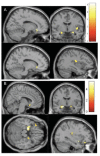Response of neural reward regions to food cues in autism spectrum disorders
- PMID: 22958533
- PMCID: PMC3436657
- DOI: 10.1186/1866-1955-4-9
Response of neural reward regions to food cues in autism spectrum disorders
Abstract
Background: One hypothesis for the social deficits that characterize autism spectrum disorders (ASD) is diminished neural reward response to social interaction and attachment. Prior research using established monetary reward paradigms as a test of non-social reward to compare with social reward may involve confounds in the ability of individuals with ASD to utilize symbolic representation of money and the abstraction required to interpret monetary gains. Thus, a useful addition to our understanding of neural reward circuitry in ASD includes a characterization of the neural response to primary rewards.
Method: We asked 17 children with ASD and 18 children without ASD to abstain from eating for at least four hours before an MRI scan in which they viewed images of high-calorie foods. We assessed the neural reward network for increases in the blood oxygenation level dependent (BOLD) signal in response to the food images
Results: We found very similar patterns of increased BOLD signal to these images in the two groups; both groups showed increased BOLD signal in the bilateral amygdala, as well as in the nucleus accumbens, orbitofrontal cortex, and insula. Direct group comparisons revealed that the ASD group showed a stronger response to food cues in bilateral insula along the anterior-posterior gradient and in the anterior cingulate cortex than the control group, whereas there were no neural reward regions that showed higher activation for controls than for ASD.
Conclusion: These results suggest that neural response to primary rewards is not diminished but in fact shows an aberrant enhancement in children with ASD.
Figures



References
-
- American Psychiatric Association. DSM-IV-TR Diagnostic and statistical manual of mental disorders (4th edition) -Text revision. Washington, D.C: American Psychiatric Association; 2000.
-
- Insel TR. Is social attachment an addictive disorder? Physiol Behav. 2003;79:251–257. - PubMed
Grants and funding
LinkOut - more resources
Full Text Sources

